Mechanical Engineering Exam > Mechanical Engineering Questions > A project consists of four major jobs for whi...
Start Learning for Free
A project consists of four major jobs for which four contractors have submitted tenders. The following is the cost matrix of assigning:
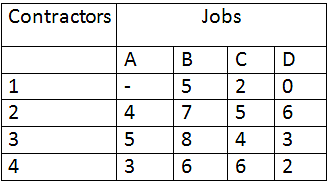
What will be the minimum total cost if contractor 1 cannot be assigned to job A? (Answer up to the nearest integer)
Correct answer is '14'. Can you explain this answer?
| FREE This question is part of | Download PDF Attempt this Test |
Most Upvoted Answer
A project consists of four major jobs for which four contractors have ...
In this case, at the position (1, A), the resource cannot be assigned. In such cases the cost of performing that particular activity by a particular source is considered to be very large (Written by M or∞ ), so as to prohibit the entry of this pair of resource-activity into the final solution.
Step 1 : Here, the number of contractors and the number of jobs each equal to 4, so there is no need to add a dummy source. Therefore, the problem is balanced and we move directly onto the next step.
Step 2 : Subtracting the smallest element of each row from every element of the corresponding row, we get the reduced matrix as:
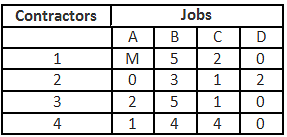
Now mark the column that do not have zero element. Subtracting the smallest element of each column of the reduced matrix from every element of the corresponding column, we get the following reduced matrix.
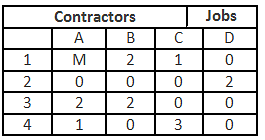
Step 3 : In the reduced matrix, make assignments in rows and columns having single zeros of the rows and columns, where assignment have been made. We get the following assignment matrix:
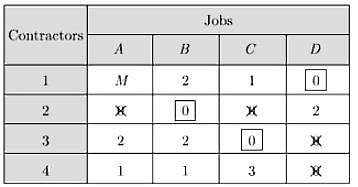
Step 4 Initial Iteration : Draw the minimum number of lines to cover all the zeros of the reduced matrix as given in matrix.
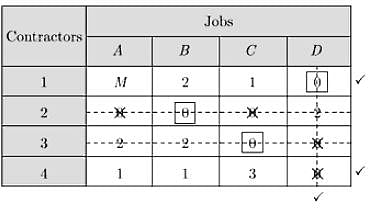
Final Iteration : Modify the reduced cost matrix by subtracting element '1' from all the elements not covered by the lines and adding the same at the intersection of two lines and now make the assignment again. This is shown in matrix below:
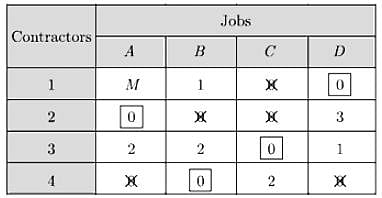
Since the number of assignments is equal to the order of the matrix, an optimum solution is reached. Also, since there are atleast two zeros for assignment in row 2 and row 4 as well as in column 1 and column 2, there exists an alternative assignment schedule. The optimum solution is :
Assign Contractor 1 to job D, Contractor 2 to job A, Contractor 3 to job C and Contractor 4 to job B or
Assign Contractor 1 to job D, Contractor 2 to job B, Contractor 3 to job C and Contractor 4 to job A.
Total minimum cost will be = 0 + 4 + 4 + 6 = 14
Attention Mechanical Engineering Students!
To make sure you are not studying endlessly, EduRev has designed Mechanical Engineering study material, with Structured Courses, Videos, & Test Series. Plus get personalized analysis, doubt solving and improvement plans to achieve a great score in Mechanical Engineering.

|
Explore Courses for Mechanical Engineering exam
|

|
Similar Mechanical Engineering Doubts
A project consists of four major jobs for which four contractors have submitted tenders. The following is the cost matrix of assigning:What will be the minimum total cost if contractor 1 cannot be assigned to job A? (Answer up to the nearest integer)Correct answer is '14'. Can you explain this answer?
Question Description
A project consists of four major jobs for which four contractors have submitted tenders. The following is the cost matrix of assigning:What will be the minimum total cost if contractor 1 cannot be assigned to job A? (Answer up to the nearest integer)Correct answer is '14'. Can you explain this answer? for Mechanical Engineering 2024 is part of Mechanical Engineering preparation. The Question and answers have been prepared according to the Mechanical Engineering exam syllabus. Information about A project consists of four major jobs for which four contractors have submitted tenders. The following is the cost matrix of assigning:What will be the minimum total cost if contractor 1 cannot be assigned to job A? (Answer up to the nearest integer)Correct answer is '14'. Can you explain this answer? covers all topics & solutions for Mechanical Engineering 2024 Exam. Find important definitions, questions, meanings, examples, exercises and tests below for A project consists of four major jobs for which four contractors have submitted tenders. The following is the cost matrix of assigning:What will be the minimum total cost if contractor 1 cannot be assigned to job A? (Answer up to the nearest integer)Correct answer is '14'. Can you explain this answer?.
A project consists of four major jobs for which four contractors have submitted tenders. The following is the cost matrix of assigning:What will be the minimum total cost if contractor 1 cannot be assigned to job A? (Answer up to the nearest integer)Correct answer is '14'. Can you explain this answer? for Mechanical Engineering 2024 is part of Mechanical Engineering preparation. The Question and answers have been prepared according to the Mechanical Engineering exam syllabus. Information about A project consists of four major jobs for which four contractors have submitted tenders. The following is the cost matrix of assigning:What will be the minimum total cost if contractor 1 cannot be assigned to job A? (Answer up to the nearest integer)Correct answer is '14'. Can you explain this answer? covers all topics & solutions for Mechanical Engineering 2024 Exam. Find important definitions, questions, meanings, examples, exercises and tests below for A project consists of four major jobs for which four contractors have submitted tenders. The following is the cost matrix of assigning:What will be the minimum total cost if contractor 1 cannot be assigned to job A? (Answer up to the nearest integer)Correct answer is '14'. Can you explain this answer?.
Solutions for A project consists of four major jobs for which four contractors have submitted tenders. The following is the cost matrix of assigning:What will be the minimum total cost if contractor 1 cannot be assigned to job A? (Answer up to the nearest integer)Correct answer is '14'. Can you explain this answer? in English & in Hindi are available as part of our courses for Mechanical Engineering.
Download more important topics, notes, lectures and mock test series for Mechanical Engineering Exam by signing up for free.
Here you can find the meaning of A project consists of four major jobs for which four contractors have submitted tenders. The following is the cost matrix of assigning:What will be the minimum total cost if contractor 1 cannot be assigned to job A? (Answer up to the nearest integer)Correct answer is '14'. Can you explain this answer? defined & explained in the simplest way possible. Besides giving the explanation of
A project consists of four major jobs for which four contractors have submitted tenders. The following is the cost matrix of assigning:What will be the minimum total cost if contractor 1 cannot be assigned to job A? (Answer up to the nearest integer)Correct answer is '14'. Can you explain this answer?, a detailed solution for A project consists of four major jobs for which four contractors have submitted tenders. The following is the cost matrix of assigning:What will be the minimum total cost if contractor 1 cannot be assigned to job A? (Answer up to the nearest integer)Correct answer is '14'. Can you explain this answer? has been provided alongside types of A project consists of four major jobs for which four contractors have submitted tenders. The following is the cost matrix of assigning:What will be the minimum total cost if contractor 1 cannot be assigned to job A? (Answer up to the nearest integer)Correct answer is '14'. Can you explain this answer? theory, EduRev gives you an
ample number of questions to practice A project consists of four major jobs for which four contractors have submitted tenders. The following is the cost matrix of assigning:What will be the minimum total cost if contractor 1 cannot be assigned to job A? (Answer up to the nearest integer)Correct answer is '14'. Can you explain this answer? tests, examples and also practice Mechanical Engineering tests.

|
Explore Courses for Mechanical Engineering exam
|

|
Suggested Free Tests
Signup for Free!
Signup to see your scores go up within 7 days! Learn & Practice with 1000+ FREE Notes, Videos & Tests.
























